Class Aves
Order Cuculiformes
Family Cuculidae
Geococcyx californianus californianus—Greater Roadrunner // Geococcyx californianus conklingi—Conkling's Roadrunner
The Cuculidae includes the cuckoos and the roadrunners; only the latter has been identified within our region, although represented by two chronologic subspecies.
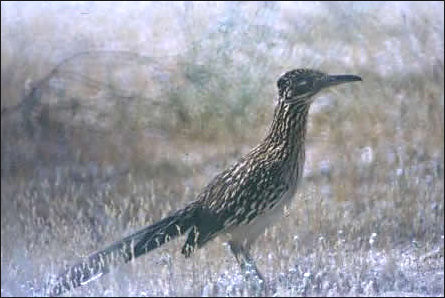 This species, widespread in
the Southwest, occurs as fossils in Arizona, California, and New Mexico. The Late Pleistocene
Californian specimens appear to be similar to modern G. californianus (Larson
1930), but Late Pleistocene specimens from Conkling Cave in southern New Mexico were
described as a larger-sized species, G. conklingi (Howard 1931a). Harris and
Crews (1983), however, found the early-Wisconsin or mid-Wisconsin roadrunner from Dry Cave to
represent G. californianus of modern size. They hypothesized that cool summers
allowed an increase in body mass to better withstand low winter temperatures, but that
during times of hot summers, the benefit of lessened body mass for summer temperature
control outweighed the effects of winter temperature. Thus inland populations were
selected for larger size during the late Wisconsin conditions of cool summers and
winters, but were selected for smaller size similar to the present populations during times with hot
summers. Thus the two taxa were considered to represent chronologic subspecies.
This species, widespread in
the Southwest, occurs as fossils in Arizona, California, and New Mexico. The Late Pleistocene
Californian specimens appear to be similar to modern G. californianus (Larson
1930), but Late Pleistocene specimens from Conkling Cave in southern New Mexico were
described as a larger-sized species, G. conklingi (Howard 1931a). Harris and
Crews (1983), however, found the early-Wisconsin or mid-Wisconsin roadrunner from Dry Cave to
represent G. californianus of modern size. They hypothesized that cool summers
allowed an increase in body mass to better withstand low winter temperatures, but that
during times of hot summers, the benefit of lessened body mass for summer temperature
control outweighed the effects of winter temperature. Thus inland populations were
selected for larger size during the late Wisconsin conditions of cool summers and
winters, but were selected for smaller size similar to the present populations during times with hot
summers. Thus the two taxa were considered to represent chronologic subspecies.
Fig. 1. Greater Roadrunner. Photograph by Jim Rorabaugh, U.S. Fish and Wildlife Service.
Literature. Harris 2003; Harris and Crews 1983; Howard 1931a; Larson 1930.
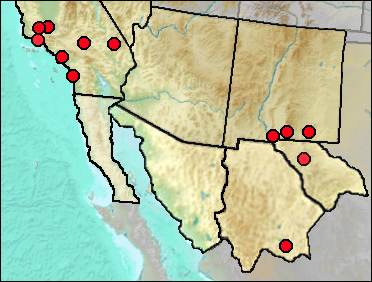
Roadrunners from California are assumed here to be of this subspecies.
Conkling 1932) reported G. californianus from Conkling Cavern, but presumably this is based on material later described as G. conklingi by Howard (1931a). Shelter Cave includes both subspecies of roadrunner, but this subspecies apparently is represented only by Holocene material at that site (Howard 1931a).
The sole specimen from Pendejo Cave identified as this subspecies is from Zone O (>55,000 BP). Other specimens from the Mid Wisconsin appear to represent B. c. conklingi. The specimen from Sierra Diablo Cave almost certainly is Holocene and is not mapped.
The Rancho del Oro specimens are placed in this chronological subspecies on the basis of Guthrie's statement (2010:5), "These bones are at the small end of the size range for the living species...."
Sites.
Rancholabrean: Cool Water Coal Gasification Solid Waste Site (Jefferson 1991a).
Rancholabrean/?Early Holocene: Mitchell Caverns (Jefferson 1991a).
Late Pleistocene: Rancho del Oro (Jefferson 2014).
Wisconsin: Carpinteria (Guthrie 2009).
Early/Early-Mid Wisconsin: Rm Vanishing Floor (Harris and Crews 1983).
Mid Wisconsin: McKittrick (Jefferson 1991a); Pendejo Cave (Harris 2003).
Mid/Late Wisconsin/Holocene: Jimenez Cave (Messing 1986); Rancho La Brea (Stock and Harris 1992); Sierra Diablo Cave (UTEP).
Late Wisconsin: Maricopa (Jefferson 1991a).
Holocene: Shelter Cave (Howard 1931a).
Literature. Conkling 1932; Guthrie 2009, 2010; Harris 2003; Harris and Crews 1983; Howard 1931a; Jefferson 1991a; Messing 1986; Stock and Harris 1992.
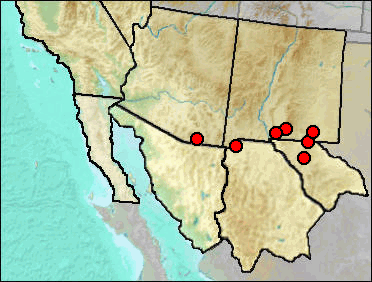
Synonyms. Geococcyx conklingi.
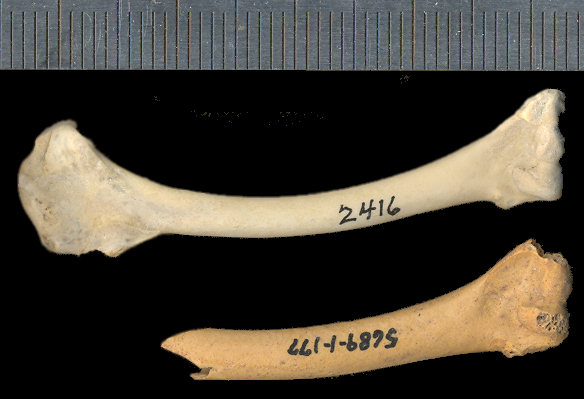 Conkling
Cavern, Doña Ana Co., NM, is the type locality (Howard 1931a). Howard stated
that there were seven bones taken at different levels and parts of the cave. She also
mentioned Geococcyx bones from Shelter Cave excavated in 1930 that include bones
even larger than those from Conkling Cavern as well as some elements comparable to
modern roadrunner bones. She noted that some of the bones from Shelter Cave are
definitely modern and some others that might be younger than the large form.
Conkling
Cavern, Doña Ana Co., NM, is the type locality (Howard 1931a). Howard stated
that there were seven bones taken at different levels and parts of the cave. She also
mentioned Geococcyx bones from Shelter Cave excavated in 1930 that include bones
even larger than those from Conkling Cavern as well as some elements comparable to
modern roadrunner bones. She noted that some of the bones from Shelter Cave are
definitely modern and some others that might be younger than the large form.
Fig. 1. Distal three-quarters of fossil Conkling's Roadrunner humerus (bottom; U-Bar Cave, 5689-1-177) compared with modern Greater Roadrunner (UTEP 2416). Metric scale.
Howard (1931a) named cotypes: Distal end of humerus Los Angeles Museum No. 118, 32-35 foot level; femur, no. 113, 29-32 foot level; ulna shaft, no. 119, 35-38 foot level. Referred material included shafts of two femurs, no. 114 and 115, 35-38 and 23-26 foot level; humeral shaft, no. 117, 35 foot level; distal tibiotarsus, no. 116, 23-26 foot level.
| Element | Measurements of Cotypes (Howard 1931a) |
|---|---|
| Humerus no. 118 | Breadth and depth distal end 11.2 mm and 5.8 mm; breadth and depth shaft immediately proximal to ectepicondylar prominence, 7.1 mm and 3.7 mm. |
| Femur 113 | Head to internal condyle length 57.5 mm; least breadth shaft 5.0 mm; depth at same point, 4.7 mm; breadth and depth of distal end, 11.4 mm and 10.7 mm. |
| Shaft of ulna | Breadth and depth measured between third and fourth papillae from distal end 4.1 mm and 2.6 mm. |
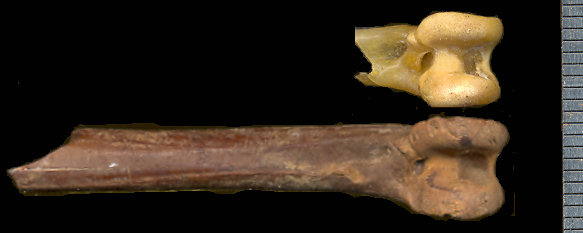 Aside
from the size differences, Howard (1931a) noted (and illustrated) that the
ectepicondylar prominence forms a more acute angle with the shaft of the humerus in
G. conklingi compared to G. californianus.
Aside
from the size differences, Howard (1931a) noted (and illustrated) that the
ectepicondylar prominence forms a more acute angle with the shaft of the humerus in
G. conklingi compared to G. californianus.
Fig. 2. Distal tibiotarsus of a fossil Conkling's Roadrunner (U-Bar Cave, 5689-1-133) compared to the distal end of a modern Greater Roadrunner tibiotarsus (UTEP 1463). Millimeter scale.
Rea (1980) (with Rob McKenzie) reexamined and compared with the type series a proximal end of a tibiotarsus from Pratt Cave that Hargrave had identified as Geococcyx conklingi and concluded that it does appear to be that taxon. He also noted that it is slightly larger and the characters are somewhat different.
Harris and Crews (1983) indicated that a specimen from the Khulo Site likely is a member of this subspecies. The specimen likely is early Holocene, suggesting that the larger form lasted through the cooler post-Pleistocene.
Sites.
Mid Wisconsin: Kartchner Cave (Carpenter and Mead 2003); Pendejo Cave (Harris 2003); U-Bar Cave (Harris 1987).
Mid Wisconsin-Holocene: Shelter Cave (Howard 1931a); U-Bar Cave (UTEP).
Mid/Late Wisconsin: Dark Canyon Cave (Howard 1971).
Mid/Late Wisconsin/Holocene: Sierra Diablo Cave (UTEP).
Late Wisconsin: U-Bar Cave 14-15 ka (Harris 1989); U-Bar Cave 15-18 ka (Harris 1989).
Late Wisconsin/Holocene: Conkling Cavern (Howard 1931a; Howard and Miller 1933); Pratt Cave (Rea 1980).
Holocene: Khulo Site (Harris and Crews 1983: cf.).
Literature. Carpenter and Mead 2003; Harris 1987, 1989, 2003; Harris and Crews 1983; Howard 1931a, 1971; Howard and Miller 1933; Rea 1980.
Last Update: 27 May 2015